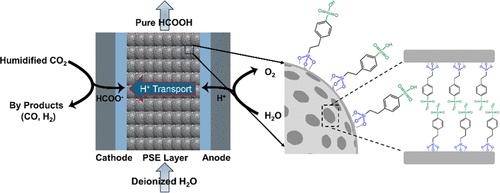磺化二氧化硅颗粒作为质子导电多孔固体电解质用于CO2电解
IF 8.2
2区 材料科学
Q1 MATERIALS SCIENCE, MULTIDISCIPLINARY
引用次数: 0
摘要
二氧化碳还原反应(CO2RR)为将二氧化碳转化为有价值的化学原料提供了一条有前途的途径,解决了环境和工业需求。然而,通过CO2RR生产的液体燃料和化学品通常含有溶解的水性电解质,需要额外的分离过程。利用多孔固体电解质(pes)的电化学CO2RR反应器可以生产不含水电解质的液体燃料和化学品,但需要能够离子传导且具有足够孔隙度的新材料。在这项工作中,我们报告了二氧化硅基颗粒可以用作二氧化碳电解的PSE。这些颗粒是通过将磺化硅烷配体接枝到介孔二氧化硅颗粒上而制备的。我们研究了2-(4-氯磺酰基苯基)-乙基三甲氧基硅烷和3-(三甲氧基硅基)丙烷-1-磺酸这两种不同的磺化配体,并将粒径从20 nm改变到40 μm,以阐明它们对连续流CO2电解槽中离子电导率和性能的影响。颗粒的离子电导率随粒径的减小而提高,电导率最高的颗粒达到5.31 × 10-2 S cm-1。我们还发现了流动稳定性和颗粒大小之间的权衡,较小的颗粒更容易在水中溶解和分散,导致流动反应器堵塞。在CO2电解槽中掺入二氧化硅,对甲酸的法拉第效率大于90%。这项工作展示了一种具有广泛应用的多孔固态电解质的新方法,包括但不限于二氧化碳电解。本文章由计算机程序翻译,如有差异,请以英文原文为准。

Sulfonated Silica Particles as Proton-Conductive Porous Solid Electrolytes for CO2 Electrolysis
The carbon dioxide reduction reaction (CO2RR) offers a promising route for converting CO2 to valuable chemical feedstocks, addressing both environmental and industrial needs. However, liquid fuels and chemicals produced through the CO2RR typically contain dissolved aqueous electrolytes, necessitating additional separation processes. Electrochemical CO2RR reactors that utilize porous solid electrolytes (PSEs) can produce liquid fuels and chemicals free of aqueous electrolytes, but new materials capable of ionic conduction and with sufficient porosity for water flow are needed. In this work, we report silica-based particles that can be used as a PSE for CO2 electrolysis. These particles were produced by grafting sulfonated silane ligands onto mesoporous silica particles. We investigated two different sulfonated ligands, 2-(4-chlorosulfonylphenyl)-ethyltrimethoxysilane and 3-(trimethoxysilyl)propane-1-sulfonic acid, and varied the particle size from 20 nm to 40 μm to elucidate their impact on ionic conductivity and performance in a continuous-flow CO2 electrolyzer. The ionic conductivity of the particles improved with decreasing particle size, and the most conductive particles achieved ionic conductivities as high as 5.31 × 10–2 S cm–1. We also found a trade-off between flow stability and particle size, with smaller particles being more susceptible to dissolution and dispersion in water, resulting in clogging of the flow reactor. Incorporation of silica PSEs in a CO2 electrolyzer produced a Faradaic efficiency greater than 90% toward formic acid. This work demonstrates a novel approach to porous solid-state electrolytes with a wide array of applications, including, but not limited to, CO2 electrolysis.
求助全文
通过发布文献求助,成功后即可免费获取论文全文。
去求助
来源期刊

ACS Applied Materials & Interfaces
工程技术-材料科学:综合
CiteScore
16.00
自引率
6.30%
发文量
4978
审稿时长
1.8 months
期刊介绍:
ACS Applied Materials & Interfaces is a leading interdisciplinary journal that brings together chemists, engineers, physicists, and biologists to explore the development and utilization of newly-discovered materials and interfacial processes for specific applications. Our journal has experienced remarkable growth since its establishment in 2009, both in terms of the number of articles published and the impact of the research showcased. We are proud to foster a truly global community, with the majority of published articles originating from outside the United States, reflecting the rapid growth of applied research worldwide.
 求助内容:
求助内容: 应助结果提醒方式:
应助结果提醒方式:


